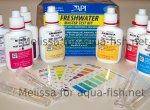Managing Ammonia, Nitrates, and Nitrites in Aquariums: A Comprehensive Guide
Quick navigation – Answers
Brief Description and Introduction
This page focuses on managing ammonia and related substances in fish tanks. It provides essential information on these issues and offers helpful resources for maintaining a healthy aquarium. For more detailed guidance, be sure to explore our related articles: Cycling an Aquarium: FAQ, Understanding Aquarium Bacteria, Ammonia Test Kits: FAQ and Examples, Filtration Media Explained, and pH Adjustment and Testing. We encourage you to share your experiences and ask questions at the bottom of this page to help us improve and support the aquarist community.
The nitrogen cycle is the process through which ammonia is transformed into nitrite, and then further converted into nitrate. This transformation is driven by beneficial bacteria that convert ammonia and nitrite, ultimately producing nitrate as the final chemical compound.
Cycling:
When setting up a new aquarium, it’s crucial to first complete a thorough cycling process. This allows the beneficial bacteria, essential for converting ammonia and nitrite, to establish themselves. In a mature aquarium, it’s equally important not to over-clean the bacterial environment to maintain a healthy nitrogen cycle. Once nitrifying bacteria are present, they can start breaking down the harmful ammonia produced by decaying plants, uneaten food, and decomposing fish waste.
Process:
As mentioned earlier, ammonia is produced by decaying plants, uneaten food, and decomposing fish waste. A specific group of bacteria is responsible for converting ammonia by combining it with water, resulting in the chemical nitrite. Then, another group of bacteria steps in, converting nitrite into nitrate by binding it with water. Ammonia and nitrite are extremely toxic to fish, while nitrate is less harmful unless it accumulates to dangerous levels. You can monitor your aquarium’s water quality by using a master test kit, available at any aquatic retail store, to check for these harmful chemicals. Regular partial water changes can help keep nitrate levels from reaching harmful concentrations.
pH Levels:
The pH level of aquarium water significantly affects ammonia levels. Water contains two forms of ammonia: pure NH3 and the ammonium ion NH4 . Pure ammonia is more toxic than the ammonium ion, but both are harmful to fish. Highly alkaline water tends to have higher levels of pure ammonia, while slightly acidic water has more ammonium ions. Although the chemical difference between the two forms is small, the impact on your fish’s health can be significant. It’s well-known that ammonia poisoning is more likely to occur in highly alkaline water.
Ammonia:
Ammonia (NH3) is a highly toxic chemical that can harm fish even in small amounts. Ammonia toxicity causes severe stress to fish, making them more vulnerable to diseases and death. It also damages gill membranes and disrupts normal breathing. Regular testing for ammonia is crucial; once a month in healthy tanks, but more frequently if there are signs of illness or death. Ideally, ammonia should be undetectable, with test results showing 0 ppm (parts per million). If any ammonia is detected, there are chemicals available that convert it into a less toxic form, which can then be processed by the bio-filter. These products don’t remove ammonia but help reduce its harmful effects. Carbon can also be used in the filtration process to improve water quality by helping to remove ammonia. It’s important to check your filter daily to ensure it’s clean and functioning properly, as a dirty or broken filter can lead to toxic ammonia levels in the tank. Avoid overfeeding your fish and overstocking the aquarium, as both can lead to excess waste and higher ammonia levels. When using medications, test the water, as some treatments can affect the bacteria that process ammonia. Regular cleaning is essential, but be careful not to over-clean the bio-filter, as it plays a critical role in maintaining the nitrogen cycle.
Nitrite:
When ammonium ions (NH4 ) mix with water, beneficial bacteria convert the ammonia into nitrite (NO2-). Like ammonia, nitrite is toxic and can cause significant harm to fish. If nitrites are present in the aquarium, they can cause severe stress, leading to respiratory problems and a weakened immune system, making fish more prone to disease and death. To prevent this, regularly test for nitrite, just as you would for ammonia. It’s important to note that even if ammonia levels are at 0 ppm, nitrite levels could still be harmful, so each substance should be tested individually as part of your routine aquarium maintenance.
Nitrate:
When nitrite (NO2-) is converted by beneficial bacteria, it becomes nitrate (NO3-). Nitrate is less harmful to fish than ammonia or nitrite, but it can still be dangerous in high concentrations. While some nitrate is usually present in aquariums, excessive levels can negatively affect fish health. High nitrate levels can indicate too much fish and plant waste in the tank, leading to unhealthy fish and encouraging algae growth. Algae can cloud the water and increase the levels of toxic ammonia and nitrite. Therefore, it’s important to regularly test for nitrate, even though small amounts are acceptable. Your nitrate levels should be 40 ppm or lower - the lower, the better. If nitrate levels are too high, there are several ways to reduce them. Partial water changes should be done immediately if levels are dangerously high. You can also use a tap water filter to remove chemicals, including ammonia, nitrite, and nitrate. If needed, a nitrate-removing filter can also be effective.
Fishless Cycling:
As mentioned earlier, cycling your aquarium is a crucial step in setting up a new tank. Without the beneficial bacteria that break down ammonia and nitrite, your first fish are unlikely to survive. Fishless cycling is a method developed to establish these bacteria in a new aquarium without putting any fish at risk. This approach also speeds up the process, taking about three weeks instead of the usual six. To start, add pure ammonia to the water when setting up the tank. Continue adding small doses of ammonia daily, and monitor the levels with daily tests. Once the bacteria responsible for breaking down ammonia have developed, you’ll notice the ammonia levels quickly drop to 0 ppm. Keep adding small amounts of ammonia daily to allow nitrite levels to rise. This increase will encourage the growth of new bacteria that convert nitrite to nitrate. Once your tests detect nitrate, perform a partial water change, wait a bit, and then test the water again for ammonia, nitrite, and nitrate. If the results are favorable, your tank is ready for fish. The waste produced by the new fish will provide the ammonia needed to maintain the nitrogen cycle.
Tips for Safely Cleaning Your Aquarium:
After establishing a colony of beneficial bacteria, it’s important to protect it. While cleaning your aquarium is essential for the health of your fish, preserving these good bacteria is just as vital. That’s why partial water changes are recommended. Keeping some of the old water in the tank helps the remaining bacteria multiply and replenish. A full water change can remove too much bacteria, potentially causing spikes in ammonia and nitrite levels, which could harm or kill your fish. Also, avoid using any cleaning chemicals that aren’t specifically labeled as safe for aquariums. Bacteria are sensitive to chemicals, and using the wrong products could destroy your beneficial bacterial colony. When cleaning filter cartridges, it’s a good idea to rinse them in the water you’ve removed from the aquarium since it already contains these helpful bacteria.
Water Test Results:
We conducted a series of tests using two different aquariums to compare their water quality. The results highlight the differences in pH, ammonia, nitrite, and nitrate levels between a healthy tank and an unhealthy one. Below, you can see the test results for a well-maintained tank versus those of a poorly maintained tank.
In "Tank A," partial water changes were done every 3 days, the fish were fed according to the food label's recommendations, and the tank was not overcrowded. The tests for pH, ammonia, nitrite, and nitrate levels confirmed that this was a healthy tank.
| Tank A | |
|---|---|
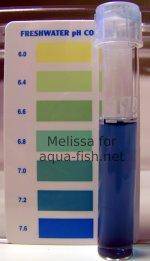 pH level 7.6 |
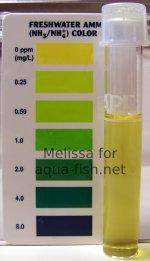 Ammonia level 0ppm |
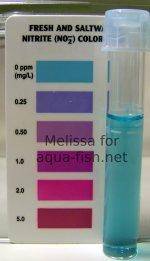 Nitrite level 0ppm |
 Nitrate level 5ppm |
In "Tank B," no water changes were done for 2 weeks, the fish were overfed, and the tank was overcrowded. When tested, the pH, ammonia, nitrite, and nitrate levels indicated an unhealthy environment by recommended standards.
| Tank B | |
|---|---|
 pH level 7.0 |
 Ammonia level 0ppm |
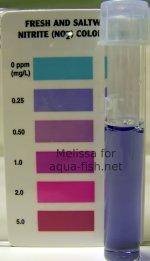 Nitrite level .25ppm |
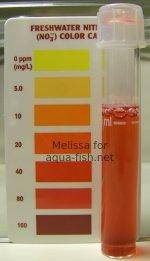 Nitrate level 50ppm |
| Tank A | Tank B | Optimum levels | Analysis | |
|---|---|---|---|---|
| pH | 7.6 | 7.0 | Between 7.0 and 7.6 | The pH levels for both aquariums are within the acceptable parameters. |
| Ammonia | 0ppm | 0ppm | 0ppm | The ammonia levels for both aquariums are at the acceptable level. |
| Nitrite | 0ppm | .25ppm | 0ppm | Tank A is healthy and has no detectable nitrite. Tank B shows the presence of nitrite which is not acceptable. Immediate maintenance should be performed on tank B. |
| Nitrate | 5ppm | 50ppm | Below 40ppm | Tank A is healthy and contains nitrate within acceptable parameters. Tank B contains levels which exceed the acceptable amount. Immediate maintenance should be performed on tank B. |
Incorporating a master test kit into your regular aquarium maintenance routine can be highly beneficial. By detecting harmful chemicals early, you can take prompt action to prevent unhealthy conditions in your tank. Maintaining healthy water levels will ensure that you can enjoy your fish for a long time.
Additional Questions and Answers
Many of aqua-fish.net's visitors arrive seeking answers to common and repetitive questions. To help, we've compiled and answered some of the most frequently asked questions below. Ideally, every visitor should read the article above to fully understand the context of the answers, especially if you're new to fishkeeping.
-
Safe Nitrate Levels in an Aquarium
40 ppm (40 mg/L)
-
Safe Nitrite Levels in an Aquarium
0 ppm (0 mg/L); any amount of nitrites is toxic to fish!
-
Acceptable Ammonia Levels for an Aquarium
The ammonia level should be nil (0 ppm or 0 mg/L). Ammonia is toxic to fish and can cause poisoning or burns, such as burned gills.
-
How to Remove Ammonia from a Fish Tank?
Start with a partial water change of up to 30% of the tank's capacity. Consider upgrading to a more powerful filter or relocating some fish if the tank is overcrowded. If you don’t have multiple aquariums, finding new homes for some fish may be necessary. Commercial ammonia removers are available, but they may not provide a long-term solution.
-
Nitrate vs. Nitrite in an Aquarium
Nitrate is produced after nitrites are converted by beneficial bacteria. While nitrites are highly toxic, nitrates can safely be present up to 40 ppm (40 mg/L). Prolonged exposure to any level of nitrate above zero can lead to health issues for fish.
-
Not harmful unless levels exceed 40 ppm (40 mg/L).


